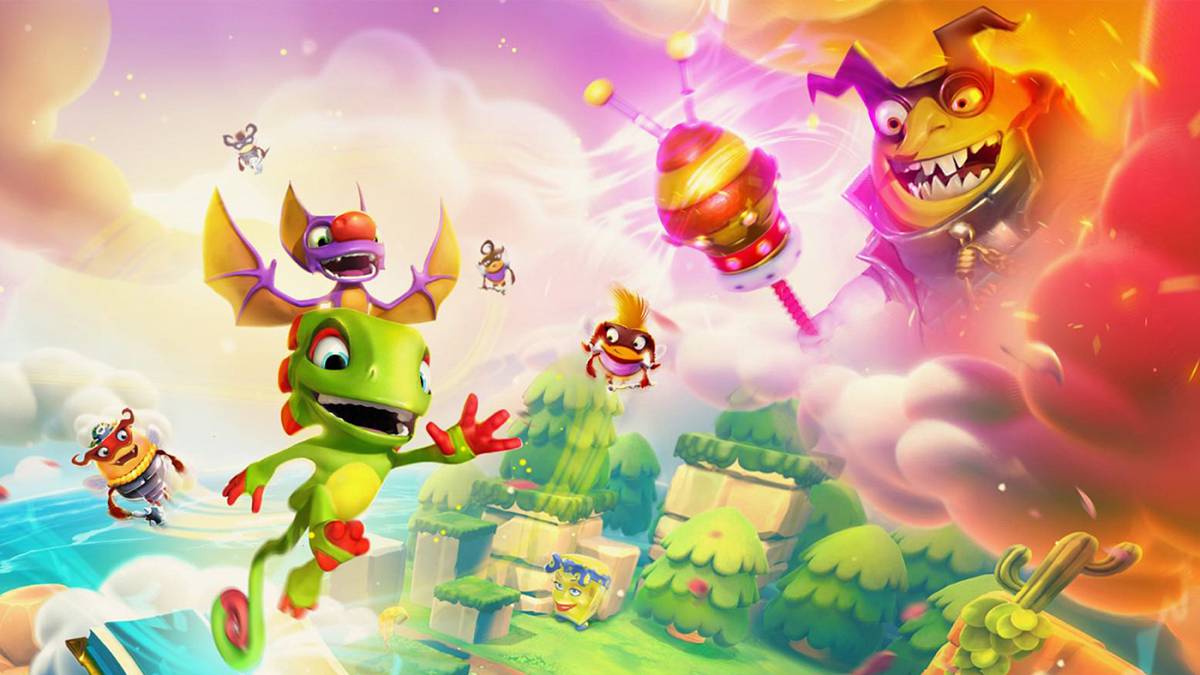
Yooka-Laylee and the Impossible Lair gets a lot of things right, and chief among them: it proves that the character platformer genre, the long-dead moneymaker of the 16-bit era, can still engage and excite in 2019. The original Yooka-Laylee was considered by most to be a good if unremarkable 3D platformer. Created by many of the same principle team behind Banjo-Kazooie, its heart was in the right place — it captured the look and atmosphere of a Banjo title, it had the same British comic sensibilities. However, its reliance on Kickstarter for funding and its use of the Unity engine meant it struggled to replicate the arresting gameplay of Banjo-Kazooie.
Developer Playtonic surely had a lot to think about. With the sequel, Yooka-Laylee and the Impossible Lair, Playtonic has gone back to platforming basics, turning to Donkey Kong Country, that other legendary Rare platformer, for inspiration. The improvement that this single change of focus makes to Yooka-Laylee can’t be overstated. The Impossible Lair feels much more like the game Playtonic was trying to make in the original — platforming that is both fun and challenging, while still paying tribute to the titles that came before it. Playtonic also isn’t above a little self-deprecation — the script takes multiple winking jabs at the original game. This especially feels like vintage Rare, who would sneak subtle jokes for grownups into their games whenever the opportunity presented itself.
The Impossible Lair sees the return of the villainous Capital B and the introduction of his latest industrial creation, The Impossible Lair. Designed to be a maddening assault on the skills and senses, The Impossible Lair does its best to live up to its name — you won’t be able to complete it right away, but the game has no problem with you giving a red hot go any time you like. Capital B has made off with Queen Phoebee’s royal beetallion, a vortex of armoured bees that keep their subject safe from harm (and some praise must be given to Playtonic for avoiding the usual trope of Kidnapping The Princess). More powerful than ever, Capital B seeks to turn his newfound invulnerability on a defenceless kingdom and it’s up to Yooka and Laylee to shut him down.
There are two parts to The Impossible Lair, the overworld and individual levels. The overworld is a top-down 3D platformer that throws simple puzzles at the player as they open the path to each new level. The Impossible Lair sits at the top of the area you first arrive in and can be attempted at any time. Individual levels are the kind of 2.5D sidescrollers you remember from the 16-bit era. Though their design certainly owes a bit of a debt to Donkey Kong Country Returns and Donkey Kong Country: Tropical Freeze, Playtonic’s levels reveal the degree to which they understand the genre, and follow a familiar ebb-and-flow — the beginning tends to introduce the theme of the level in a reasonably low-stress way, the middle section ramps up the challenge and the final section bristles with sneaky fake-outs and steeper challenges before ramping back down to the exit. You can then find modifiers for each level that ramp the challenge up even higher, like freezing them solid (just like DKC: TF), and buy Tonics, stat boosts that allow change certain elements of the experience
There are also numerous nods to other genre greats. If struck, Laylee will temporarily fly about in a panic so that you can catch her, just like Baby Mario in Yoshi’s Island. When swimming, Yooka can perform a graceful leap into the air just like Ecco the Dolphin. Yooka can grab objects with his tongue like Yoshi. You collect coins, shoot barrels and find hidden bonus levels just like in Donkey Kong Country. It’s clear that Playtonic hasn’t been particular in where they’ve looked for inspiration and its interesting to see how well many of these mechanics hold up. Good design remains good design.
Playtonic has also found their stride with The Impossible Lair’s art design. The central characters have been given a lot of love, with lots of subtle animations and expressions that keep everything feeling very fluid — Yooka’s over-stuffed face when holding objects in his mouth is a personal favourite. It’s always quite clear where you can and can’t go, and many areas are cleverly designed to reveal secrets only when you stumble into them. It’s great stuff.
Though the overall design is very strong, I did feel there was still some room for improvement. Certain levels felt like they still needed a little tightening up — one level involving spinning blades in the floor felt like it failed to take player rhythms into account, creating a staccato series of jumps. Perhaps some of the blame is on me for assuming I could bounce right over them, but by the same token, they still felt a bit unforgiving even when performed correctly. You run into it again and again throughout the game, and its one of those areas where you can feel the difference in polish between what can be accomplished by a AAA effort like Donkey Kong Country Returns and a much smaller, independent studio like Playtonic. I hope they’re given room to tinker and tighten after launch, and I hope they keep playing in this world.
![]()
![]()
![]()
![]()
![]()
FOUR STARS (OUT OF FIVE)
Highlights: Great art; Strong level design; Recaptures the DKC vibe
Lowlights: Some levels may frustrate; Others may feel its way too easy
Developer: Playtonic Games
Publisher: Team17
Platforms: PlayStation 4, Xbox One, Nintendo Switch, Windows PC
Avaiable: Now
Review conducted on Xbox One X using a pre-release code provided by the publisher.
